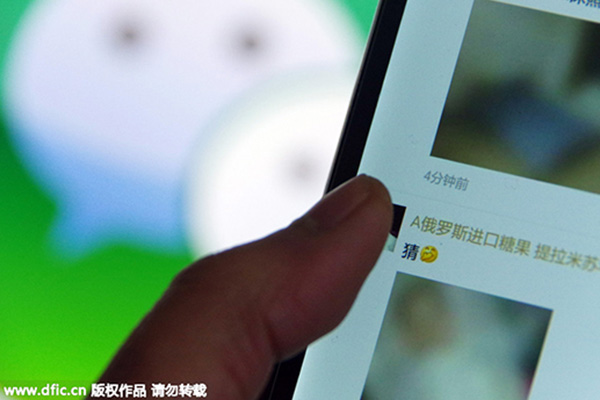 |
|
Users of social-networking app WeChat on Tuesday found their feeds full of blurred pictures, many accompanied by flirty captions. [Photo/IC] |
BEIJING - Users of social-networking app WeChat on Tuesday found their feeds full of blurred pictures, many accompanied by flirty captions. By the strike of midnight, however, they were all gone.
It was the trial run of WeChat's pay-photo, a new function tailored for the lunar new year.
While opinions were divided among 650 million active users of Wechat, many joked that their timelines were experiencing "heavy smog."
Those who wanted to see the images in their original-unblurred state had to pay the original poster a small sum. Many users spent their whole nights trying to persuade their contacts to part with cash to view their photos.
Despite the inevitable controversy over concerns that pay-photo could be used to spread pornography, if any, this simple function may arouse enthusiasm on otherwise ordinary winter nights.
Since Internet giant Tencent released the instant messaging app in 2011, WeChat has become part-and-parcel of daily lives of many.
Some critics are concerned about what they perceive to be over-dependent on this "everything app," and how nomophobia appears to be endemic among younger generations.
Ubiquity
WeChat users can talk with others, search for people nearby, share thoughts and photos, subscribe to news feeds, open their accounts for public viewing, distribute or collect money, pay restaurant checks and utility bills, order groceries and operate their own mobile stores. The list goes on, in this ecosystem.
While instant messaging was WeChat's earliest core function, it has evolved into something much bigger. Users can text message, make Internet calls via the app, leave short voice or video notes and have, in fact, video conferences. Most importantly, all of this is free.
Its social-networking function "moments" is similar to Facebook's "timeline." It is a feed made up of posts by contacts, often featuring personal posts alongside photographs, articles, songs or discount vouchers.
The "red envelope" is another popular function. It takes the Chinese tradition of giving out red envelopes containing money as a symbol of good luck, and packages it in a 21st-century digital wrapper.
"My first glance every festival day is to see if there is any red envelope," said Lei Yu, 23, from Beijing who has more than a thousand WeChat contacts.
This user dependency makes WeChat a great platform to deliver news and ads, as well as to conduct e-commerce.
